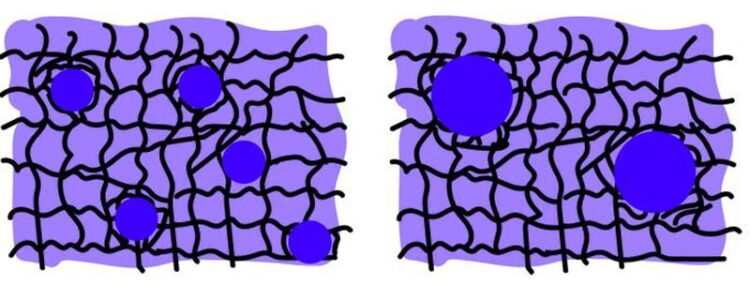Growing droplets in the matrix

Schematic illustration of the experimental setup. Depending on cooling speed, either more oil droplets of similar size (left, fast cooling) or fewer bigger droplets (right, slow cooling) are forming.
MPIDS, Estefania Vidal-Henriquez
The mechanism of molecular self-organization was assessed in a new model by researchers from the Max Planck Institute for Dynamics and Self-Organization (MPIDS). In their study, they simulated how environmental factors such as temperature influence the size of oil droplets in elastic matrices. The study will also help understanding droplet formation in biological cells, where biological molecules self-organize in condensates. The full paper was recently published in the renowned journal PNAS.
In biology, proper regulation of the cell’s interior is crucial to ensure the function of biological processes. Yet, cells can be very complex structures with several thousand different types of molecules and millions of protein copy numbers. To organize this vast complexity, several mechanisms are required to create sub-cellular environments providing both defined and dynamic conditions. For example, cellular organelles enable the segregation of cellular environments due to demarcation via membranes. However, also in the crowded cellular matrix a structured organization of biomolecules is required. There, so-called biomolecular condensates with a defined molecular composition can form spontaneously. Prominent examples of this phenomenon include stress granules and transcriptional condensates. These condensates are surrounded by elastic structural elements in the cell, including the cytoskeleton and chromatin in the nucleus. The question is: how are the condensates affected by the elastic structures and could the cell use this interaction to exert control in the dynamic cellular environment?
A model provides access to the realm of molecular organization
As it is in practical terms not possible to follow the detailed interaction of millions of molecules in a cell in real-time, researchers use models describing individual facets of the phenomenon. “We are using oil droplets to represent the material in the cytosol and a polymer mesh to mimic the biological scaffold” explains Estefania Vidal-Henriquez, first-author of the study. “The dynamic development of the droplet size under certain conditions gives us information on how biological molecules would be arranged in a cellular environment.” The model describes the distribution of different droplet sizes and their relative abundance. Moreover, it considers that the surrounding matrix might be broken – which would refer to a rearrangement of the biological scaffold. This means that the biomolecular condensates are not limited by the mesh size of its surrounding, but are capable of growing beyond.
Phase separation as the key mechanism
A powerful concept to explain the growth of such condensates is phase separation. Briefly, depending on the conditions, two substances will be either mixed or coexist separated from each other. Multiple factors may influence phase separation in biology, such as pH, concentration, or temperature. In the model, the researchers used a temperature modulation to investigate the effect of phase separation and droplet formation. Slowly lowering the temperature of the system, a spontaneous nucleation of oil droplets was observed, which were growing bigger in time by absorbing the material around them. Interestingly, at a faster cooling speed more, but smaller droplets occur. Hence, the speed at which an external factor of influence changes plays a crucial role in structure formation.
“With our model, we describe how the molecular composition can be arranged on the microscale on an elastic matrix” summarizes David Zwicker, senior author of the study and group leader at the MPIDS. Regarding the effect of temperature modulation, he adds: “We expect similar behavior for biomolecular condensates which often form as a response to changes in temperature, pH, or protein concentration in cells.” The model provides the foundation to describe the formation of microscopic patterns in both technical and biological context.
Originalpublikation:
Media Contact
All latest news from the category: Physics and Astronomy
This area deals with the fundamental laws and building blocks of nature and how they interact, the properties and the behavior of matter, and research into space and time and their structures.
innovations-report provides in-depth reports and articles on subjects such as astrophysics, laser technologies, nuclear, quantum, particle and solid-state physics, nanotechnologies, planetary research and findings (Mars, Venus) and developments related to the Hubble Telescope.
Newest articles

Innovative 3D printed scaffolds offer new hope for bone healing
Researchers at the Institute for Bioengineering of Catalonia have developed novel 3D printed PLA-CaP scaffolds that promote blood vessel formation, ensuring better healing and regeneration of bone tissue. Bone is…

The surprising role of gut infection in Alzheimer’s disease
ASU- and Banner Alzheimer’s Institute-led study implicates link between a common virus and the disease, which travels from the gut to the brain and may be a target for antiviral…

Molecular gardening: New enzymes discovered for protein modification pruning
How deubiquitinases USP53 and USP54 cleave long polyubiquitin chains and how the former is linked to liver disease in children. Deubiquitinases (DUBs) are enzymes used by cells to trim protein…


